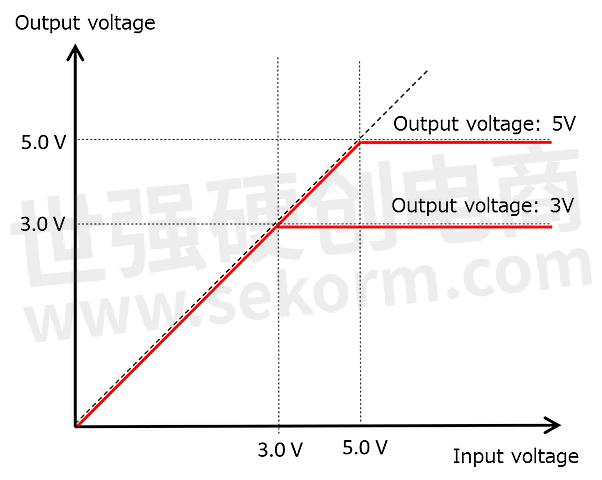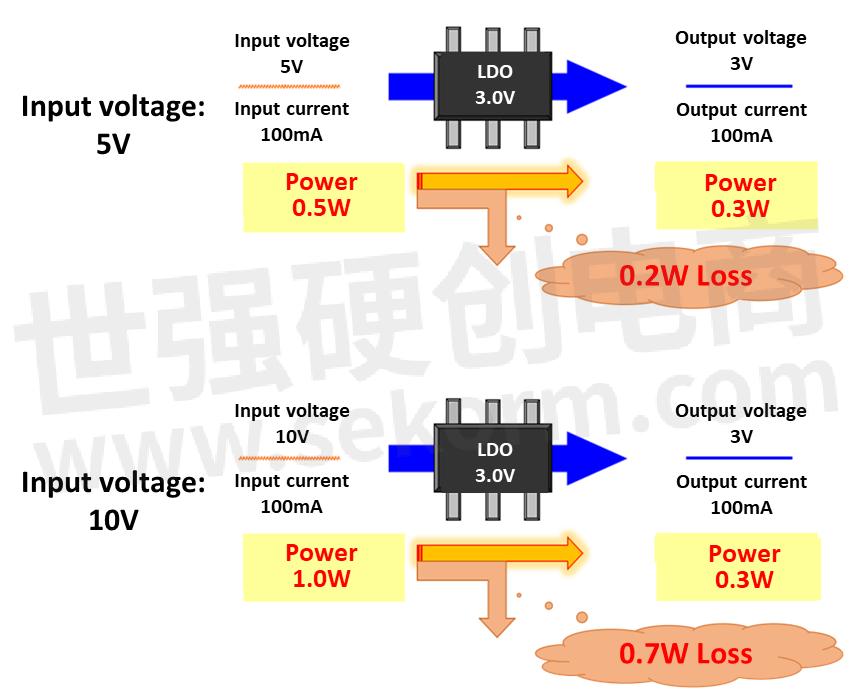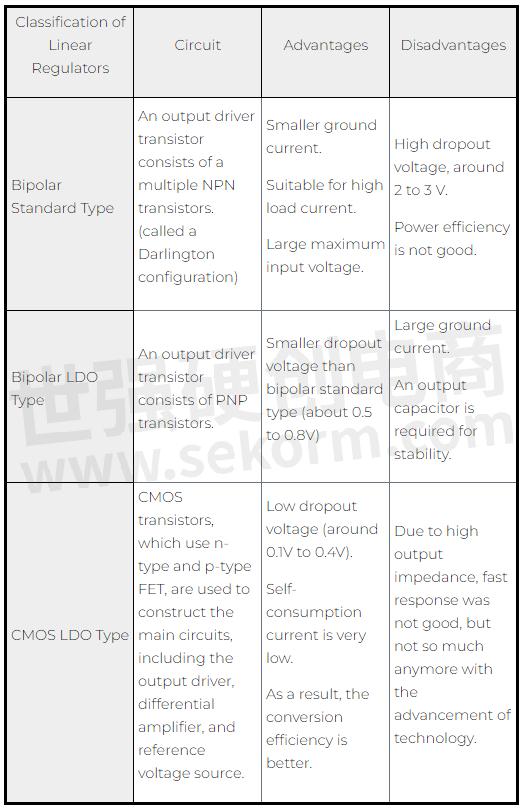What Is A Linear Regulator?

In our daily lives, we seldom hear the word "Linear Regulator". However, it is one of the electronic components that is commonly used in electronic products around us, including PCs and smartphones that you are using to read this page right now.
A linear regulator is a type of device that can output a constant voltage without being affected by fluctuations in input voltage, the current consumption of application devices, temperature, or time. It is also called a voltage regulator. Compared to a switching regulator, which is also a type of regulator, the power conversion efficiency of a linear regulator is inferior because it controls the voltage while converting and releasing the power energy into heat. On the other hand, the output voltage is very stable and noiseless, and you can configure a power supply circuit easily with a linear regulator because it requires fewer external components compared to a switching regulator.
In recent years, due to the increasing demand for low power consumption of electronic devices, switching regulator with excellent conversion efficiency has become the mainstream when constructing power supplies with high power output. However, when constructing power supplies for applications with strict noise and mounting area requirements, linear regulators with simple configuration and low noise still have many opportunities to be used.
There are two types of linear regulators depending on how the output transistor, or the variable resistor, is inserted: the series method (inserted in series between the input and the load) and the shunt method (inserted in parallel with the load). However, since the shunt method has limited applications, this article will focus on the series method only. From now on, I will use some technical terms in circuit design to explain the logic of the operation.
In this article, Nisshinbo tells what is a linear regulator, shows its advantages and disadvantages.
Operation of Linear Regulator
The simplest linear regulator is called a three-terminal regulator, which has three terminals (pins): input, output, and GND. The chip enables (CE) pin, which controls the ON/OFF of the chip operation itself, has been added to the regulator, and now there are many products with four or more pins.
Now let's take a look at what is inside it. Generally, a linear regulator consists of a negative feedback control circuit with four components: an output driver transistor, a feedback resistor, a reference voltage source, and a differential amplifier (error amplifier). To this circuit, a linear regulator is completed by simply adding one capacitor on the input side and another on the output side for phase compensation.

Figure 1. Circuit Diagram of a Linear Regulator
Among the four components mentioned above, the output driver transistor, which behaves like a variable resistor, is finally responsible for converting the input voltage into a constant output voltage. As the name implies, a variable resistor is a resistor that can change its resistance value. The output voltage of the linear regulator is maintained at a constant voltage level by fine-tuning the resistance value with the feedback of the output voltage.
The following figure shows the output characteristics of a linear regulator. The reason that this type of device is called a linear regulator is that it outputs the input voltage in a linear manner.

Figure 2. Output Characteristics of Linear Regulator
The principle of its voltage conversion is based on Ohm's Law, familiar to us from junior high school science textbooks, and the following formula can be used to calculate resistance and power consumption.

Advantages and Disadvantages of Linear Regulators
Now, I would like you to remember an experiment we did in junior high school. While the current is flowing, a resistor emits heat. This heat means that some of the input power has been consumed as heat.
In fact, the linear regulator has a disadvantage in that the conversion efficiency tends to be low because the unnecessary power is consumed as heat. In particular, the larger the difference between the input voltage and output voltage (input-output voltage difference), the more obvious this tendency becomes. In addition, if the heat generation exceeds a certain level, it will lead to the failure of the electronic equipment, so the thermal design is very important with the allowable package power dissipation of the IC taken into consideration.

Figure 3. Losses when Inputting 5 V and 10 V to a 3 V Output Regulator
While there is a disadvantage to low conversion efficiency, there is of course an advantage. In addition to the above-mentioned simple circuit configuration and ease to reduce the mounting area, the merit of the linear regulator is that the output voltage has fewer unnecessary frequency factors (noise). Therefore, for noise-sensitive devices such as audio, a power supply configuration with a linear regulator is often used to remove noise from the voltage from a switching regulator, which has high conversion efficiency but has noise.
Types of Linear Regulators
Linear regulators can be classified according to the configuration of the output driver and the circuit configuration to the ground. When the linear regulator first came into use, an NPN Darlington configuration using multiple NPN transistors was the standard.
However, Darlington-type linear regulators have various drawbacks in terms of efficiency of voltage conversion, such as a large lower limit of dropout voltage, which is the minimum requirement of the voltage difference between input and output voltages, large resistance value, large power (current) required to operate (in other words, discarded power that must be released is large).
With the development of technology and the emergence of portable battery-powered devices such as cell phones and notebook PCs, linear regulators that can convert voltage with low consumption and high efficiency are required to ensure that these devices can operate for a long time. Therefore, the low dropout voltage regulator, or LDO regulator, which can suppress power loss by reducing the difference between the input voltage and output voltage (input-output voltage difference), has become a major product.
Today, the demand for low power consumption has become even stronger, and CMOS LDO regulators that can achieve low power consumption are playing an increasingly important role.
Table 1. Classification of Linear Regulators

- +1 Like
- Add to Favorites
Recommend
- 3PEAK Unveils TPL8033, a Next-generation Linear Regulator Featuring Ultra-low Noise and Ultra-high PSRR
- 5V/3A Linear Regulator FLD0530 Designed for Low Dropout and High Current Applications
- The Linear Regulator XBLW AMS1117 with Output Current Capability up to 1A and Output Voltage Accuracy of ±1.5%
- 2μA/600mA Linear Regulator DS8562B Offered the Benefits of Wide Input Voltage Range from 1.2V to 5.5V and ±1% Output Accuracy
- Principle and Application of Linear Regulator LDO
- Linear Voltage Regulator HM6220 Guaranteed 150mA Output and Offered Better than 1% Initial Accuracy
- Crocus Technology’s CT100 1D Linear Sensor Contactless TMR Field Sensor with Differential Outputs
- Nisshinbo Launched Development of First MUSES-Series High-sound-quality Power Management IC
This document is provided by Sekorm Platform for VIP exclusive service. The copyright is owned by Sekorm. Without authorization, any medias, websites or individual are not allowed to reprint. When authorizing the reprint, the link of www.sekorm.com must be indicated.





























































































































































































































































































































































































































































































































































































































































































































































































































































































